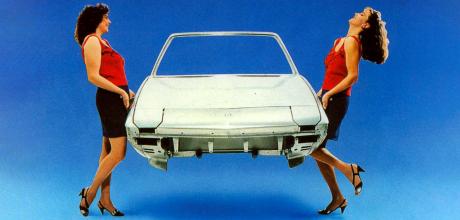Aluminium-bodied Fiat X1/9 prototypes

Our Italian correspondent, Matteo Licata, recalls how aluminium-bodied Fiat X1/9 prototypes were tested to destruction in… Nuneaton
Blind ‘Ally’
This year marks the 50th anniversary of the Fiat X1/9, which was presented in Sicily in November 1972. Much has been written about this brilliant mid-engined sports car, but to me, one of the most intriguing facets of X1/9 history is the one described in SAE paper number 890718, whose rather clunky title reads: ‘The Building and Test Track Evaluation of an Aluminium Structured Bertone X1/9 Replica Vehicle’.
The key word here is ‘replica’, as the point of the experiment was to demonstrate how Canadian aluminium company Alcan's adhesive bonding technologies could replace steel for aluminium, keeping the existing design largely unchanged. Alcan approached Bertone in 1986, and five aluminium-bodied X1/9s were duly constructed.
The aluminium panels were press-formed with the same gauges as their steel counterparts (between 0.7 and 2.5 mm) and then spot-welded, with bonded-in doublers and additional brackets placed wherever the mechanical properties of aluminium were deemed insufficient for the job.
One of the aluminium bodies was then subjected to static testing – interestingly, at Austin Rover's R&D facility in Gaydon. The results made for interesting reading: the experimental aluminium body weighed 136.6kg, a whopping 30% less than its steel equivalent (197kg), while offering comparable torsion stiffness (3155 Nm/degree versus 3100). However, it must be said that the bodyshell's bending stiffness was far less convincing: 18% less than its steel counterpart (2490N/mm versus 3040).
The five cars were fully trimmed and assembled at the same assembly line that built the ‘regular’ X1/9, and then tested to destruction at MIRA's facility in Nuneaton, with results that sometimes make for grim reading. For example, after nearly 600 miles of unforgiving Belgian pavé roads, both rear suspension turrets cracked so severely that they had to be repaired to allow testing to proceed any further.
However, the prototype bodies did not deform and maintained their rigidity – remarkable given that the X1/9's body hadn't been designed for aluminium and doubling panels had been impossible in some areas. But that was the whole point of the exercise: demonstrating that aluminium bodyshells were possible and even compatible with existing production facilities – even if the way those X1/9s were built would undoubtedly make Audi engineers squirm.
One of the five prototypes met its demise in a 30mph frontal crash test at Fiat's safety centre in Turin. Although the results wouldn't impress today’s Euro NCAP officials, they were comparable to the regular X1/9 and well within the legal requirements of the time. Of the five aluminium X1/9s built, one survived its various test ordeals to be tucked away in Bertone's company museum, with only a few decals hinting at its uniqueness. It's currently on display at the Volandia museum near Milan Malpensa airport, together with 79 other vehicles and prototypes purchased in 2015 by the Automotoclub Storico Italiano following Bertone's bankruptcy.

